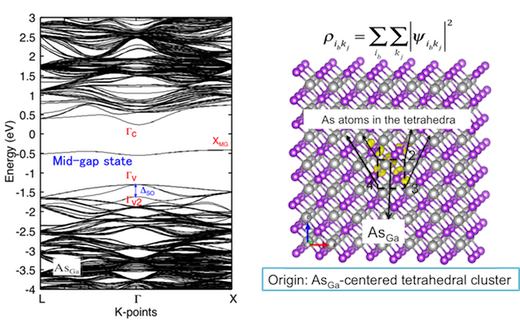I. Investigation of spin current to charge current conversion and THz emission in new 2D hybrid materials
THz radiation, which lies between the microwave and infrared region of electromagnetic spectrum, coincides with excitation of many systems, making it suitable for low-energy spectroscopy, biomedical imaging, security, among others. However, the prevalent THz gap {roughly around 0.1 THz to 0.10 THz} exists for the lack of efficient THz radiation emitters. The recently studied spintronic THz emitters made from ferromagnetic (FM)/non-magnetic (NM) {e.g. Fe(2nm)/Pt(3nm)} exhibit ease of operation, durability and broadband THz emission but use precious metals. This research aims to first study theoretically and experimentally the spin-to-charge conversion and THz emission from 2D on FM not by inverse spin-hall effect as in the conventional FM/NM emitters.
II. Investigation of photoconductivity by sub-band gap optical excitations
半導体のサブバンドギャップ光励起による光伝導度の研究
Photoconductivity by sub-bandgap optical excitations (SOEP) can be used for low-noise photoconductive detector and efficient photoconductive emitter for THz radiation. The low-temperature molecular beam epitaxy-grown GaAs (LT-GaAs) is a typical semiconductor, which exhibit SOEP, however mechanisms are still elusive. Here, we integrated spin-orbit coupling (SC) to our first-principles calculation of GaAs bulk with As-antisite defect. SC arises from the broken inversion symmetry of GaAs. The calculated bandstructure revealed a mid-gap state of energy level consistent with pump wavelength [1]. The structural origin of this state and how to directly observe/probe it using GaAs(110) surface are revealed by simulated and experimental scanning tunneling microscopy (STM) [2].
Calculation of mid-gap gap state of energy level consistent with pump wavelength made possible by incorporating spin-orbit coupling

Directly probing the above defect on a surface using calculated and experimental STM

[1] MC Escaño et al, Appl. Surf. Sci. 511 (2020) 145590. [2] MC Escaño et al, Mater. Res. Express 6 (2019) 055914.
III. Magnetic phase transition of magnetic multilayers/alloys/metal oxides
磁性多層/合金/金属酸化物の磁気相転移の研究
More often, the application of magnetic systems in real devices requires understanding of their magnetic phase transition in real environment. Here, we study such property of multilayers/alloys/metal oxides using combined density functional theory (DFT), constrained local moment approach (CLM) and monte carlo (MC) simulations simulations. The MC simulation code is developed in-house.
Calculation of magnetic phase transition of Fe and Co substrates and the Pt layer deposited on them using in-house developed Monte-Carlo Simulation Code.

Up to FY 2017 (2017年度までの研究)
IV. Science of magnetic systems in biological/chemical environment by quantum simulation
Magnetic systems such as magnetic multilayers or alloys, carbon structures, reactants and certain metal surfaces have now been used in many kinds of industrial applications. In particular, the oxygen reaction on surfaces has been a vital reaction in CO oxidation, oxygen-reduction-reaction (ORR) and corrosion, among others. The fundamental theoretical study of this reaction with explicit treatment of the magnetic states of the reactants is needed to elucidate the mechanisms of various observed phenomena. In this research, first-principles methods such as density functional theory and Monte-Carlo simulations are employed to draw the reactivity as well as stability mechanisms of these catalytic-magnetic systems. Examples are given below:
第一原理計算法による生物環境・化学環境中における磁気システムの研究
合金、金属酸化物、スピン偏極炭素、 遷移金属(3d)といった磁気システムは、その資源量が豊富であるため近年工業的利用が注目されている。特に、これらのシステムでの酸素の反応は、エネルギーデバイス(燃料電池、リチウム電池等)や電子デバイスの重要な反応の一つである。また、磁気システムは、生物学的システムの一部である。このような化学環境中における磁気システムの基礎研究(原子レベル)により、安定性・構造、相互作用メカニズム、界面特性、磁気相転移、ダイナミクスに関する極めて重要な情報を得ることが期待される。本研究では、反応物質の磁性状態の理論的検討を可能にする密度関数理論(DFT)やモンテカルロシミュレーション(MC)のような第一原理法を用いることにより、このような情報に関する詳細な検討を実施している。得られた結果は、種々の実験的観察の補完や、より優れた素材開発のための新しい設計指針の提案に活用できると考えている。研究例は、以下の通りである。

A. Stability of magnetic alloys under oxygen environment
Experiments have shown that components of metal alloys can degrade under oxygen environment. Using spin-polarized density functional theory, the mechanism of the oxygen-induced degradation of metal alloys such as Pt-Co is elucidated. This mechanism is further used to create new ternary alloy design concepts leading to more stable ORR nanoparticle catalysts.
酸素環境中における磁性合金の安定性の研究
実験により、酸素環境中における磁性合金の成分の劣化が知られている。DFTを用いることにより、Pt-3dの酸素誘発劣化のメカニズムを理論的に解明することに成功した。このメカニズムに基づいて新しい三元合金構造をデザインすることができると考えている。
Mechanism of Effect of Oxygen on Pt/Co Stability via Quantum Simulation

New ternary alloy design concepts

B. Reactivity of spin-polarized systems
Graphene is inert to many reactants including oxygen. However, due to its abundance, ease of production and high conductivity, various means to enhance its reactivity have been studied. Conventionally, geometric effects (doping , cutting to form semi-infinite nanoribbons, straining) have been imposed to alter its chemical reactivity. In this research, the exchange splitting of unstrained and uncut (infinite) graphene using ferromagnetic substrate is used to alter its electronic structure in favor for better reaction. This method allows all carbon atoms to act as reactive sites. The electronic mechanism of the enhanced reactivity of graphene is drawn using spin-polarized density functional theory.
スピン偏極炭素の反応性の研究
グラフェンは、酸素を含む多くの反応物質に不活性である。しかしながら、大量に存在し、生産しやすく、高伝導性であることから、様々な方法で反応性を向上させる研究が行われてきた。従来法では、ドーピング等による幾何学的効果が反応性の向上に利用されてきた。本研究では、より優れた酸素反応を得るため、磁性基板を用いたグラフェンの電子構造の変化に着目し、すでに、対酸素反応において磁性グラフェンがドープされたグラフェンとは異なった注目すべき変化を示す場合があることを見出している。本研究には、酸素の相互作用の電子機構に関してDFTを用いており、本現象のメカニズムを解明することにより、さらに新しい反応性グラフェン構造の作成に利用できると考えている。

C. Spin-dependent oxygen adsorption energetics on ferromagnetic surface
Experimental investigation of spin-dependent adsorption of oxygen requires its complete polarization using a ferromagnetic material. Potential energy surface (PES) corresponding to different spin states of oxygen on a ferromagnetic surface is so far non-existent. First-principles methods are being conducted to obtain the PES and to elucidate the mechanism of spin-dependent O2 adsorption. In particular, the constrained density-functional theory is employed to restrict the molecule’s and surface’s spin moment directions throughout the reaction pathway. Monte-Carlo simulation is used to determine the sticking probabilities.
強磁性体表面におけるスピン依存性の酸素吸着の研究
酸素のスピン依存性吸着の実証研究には、磁性物資を用いた完全偏極が不可欠である。そのため、磁気面における酸素の異なるスピン状態(三重項および一重項)と一致するポテンシャルエネルギー面(PES)が必要となる。 PESを得るため、またスピン依存酸素吸着構造の解明のため第一原理法(Constrained DFT)を用いて検討を行っている。また、検討結果を実験と直接比較するためにモンテカルロシミュレーション等を用いて付着確率を決定している。
Spin-dependent energetics and sticking probability of oxygen on magnetic surface using constrained DFT

